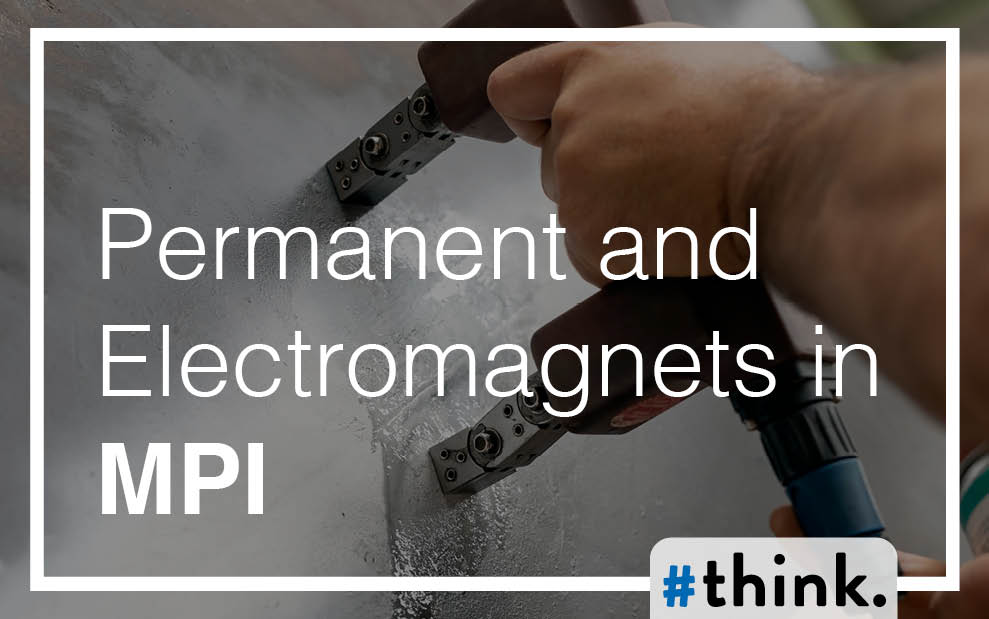Introduction
Magnetic Particle Inspection (MPI) is a powerful non-destructive testing (NDT) technique used extensively across industries to detect surface and near-surface flaws in ferromagnetic materials. At the heart of MPI lie two types of magnets: permanent magnets and electromagnets. In this blog, we will delve into the fascinating world of MPI and explore the roles of permanent and electromagnets in this crucial inspection method.
The Basics of Magnetic Particle Inspection
Before we dive into the types of magnets used in MPI, let’s briefly review how MPI works:
Magnetisation: The process begins by magnetising the object under examination. This is achieved by generating a magnetic field within the material, rendering it temporarily magnetised. This magnetic field induces magnetic flux leakage at areas with surface flaws or discontinuities.
Magnetic Particles: Magnetic particles, usually made of iron or iron oxide, are then applied to the surface of the magnetised object. These particles are drawn towards areas where the magnetic field is distorted due to the presence of defects.
Visualisation: As the magnetic particles accumulate at defect sites, they create visible indications, often appearing as dark lines or patterns on the surface. Skilled inspectors interpret these indications to assess the size, shape, and location of flaws.
Permanent Magnets in MPI
Permanent magnets are magnets that retain their magnetism without the need for an external power source. In MPI, they are commonly used for smaller and more localised inspections. Here are some key points about the role of permanent magnets:
Portability: Permanent magnets are highly portable and require no electricity, making them ideal for field inspections where power sources may be limited or impractical.
Magnetic Yokes: A common form of permanent magnet used in MPI is the magnetic yoke. These yokes consist of two magnets that are brought together, creating a strong magnetic field at their tips. When placed on opposite sides of the object under inspection, they induce magnetism, allowing for the detection of surface flaws.
Localised Inspection: Permanent magnets are best suited for localised inspections, such as welds, small components, and areas where defects are expected to be shallow or near the surface.
Electromagnets in MPI
Electromagnets, on the other hand, are magnets that require an external electrical current to generate a magnetic field. They offer distinct advantages in MPI:
Controlled Magnetisation: Electromagnets provide precise control over the strength and direction of the magnetic field, allowing for tailored inspections of various materials and sizes.
Versatility: Electromagnets are versatile and can be used for both localised and full-scale inspections. They are often used in laboratory settings and for inspecting larger and more complex components.
Demagnetisation: Electromagnets can easily be demagnetised after inspection, ensuring that the tested material does not retain residual magnetism, which could interfere with subsequent processes or operations.
Depth of Inspection: Electromagnets are capable of inspecting deeper into the material than permanent magnets, making them suitable for identifying deeper flaws or discontinuities.
Choosing the Right Magnet for the Job
The choice between permanent and electromagnets in MPI depends on various factors, including the size and geometry of the object under inspection, the depth at which defects are suspected, and the availability of power sources.
For portable and quick inspections of small components or field applications, permanent magnets, particularly magnetic yokes, are a practical choice due to their simplicity and ease of use.
For larger and more complex structures, electromagnets offer the versatility and control needed to perform comprehensive inspections. They are especially valuable in laboratory settings where precision is paramount.
Conclusion
Magnetic Particle Inspection is a vital tool in ensuring the integrity and safety of critical components in various industries. Both permanent and electromagnets play crucial roles in this NDT method, offering distinct advantages depending on the specific application. Permanent magnets excel in portability and simplicity, while electromagnets provide precision and versatility. The choice between these magnets depends on the specific inspection requirements. Electromagnets provide precision and versatility. The choice between these magnets depends on the specific inspection requirements, but both contribute to the reliable detection of surface and near-surface flaws, ultimately enhancing safety and quality across industries.
Looking for Magnetic Particle Inspection?
Let’s talk : 0800 433 7859

